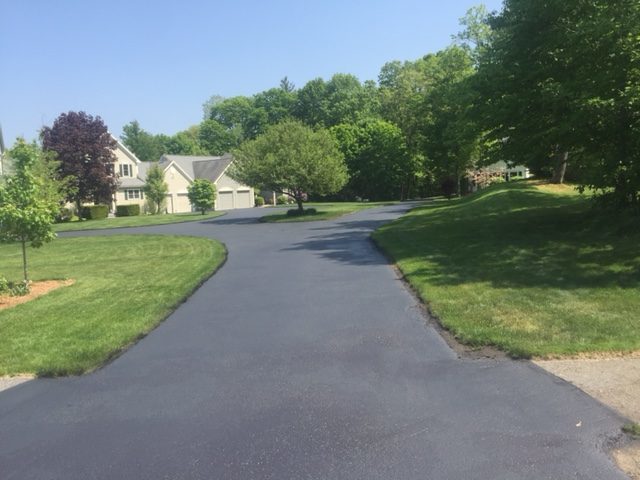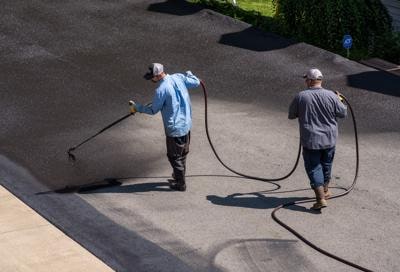Cold Mix Asphalt Vs. Hot Mix Asphalt: Which Is Right for You?

Composition Differences
Cold mix asphalt is generated by emulsifying the asphalt binder with water and an emulsifying representative prior to mixing it with accumulation. The warm mix asphalt production process entails warming the accumulation and asphalt binder individually before combining them at the asphalt plant.
Furthermore, chilly mix asphalt has a tendency to be much less thick and much more flexible than warm mix asphalt. This flexibility makes it better matched for locations with higher degrees of motion, such as driveways or roadways with heavy web traffic. In contrast, hot mix asphalt is understood for its high sturdiness and resistance to rutting and splitting, making it a recommended selection for freeways and high-traffic roadways where longevity is crucial.
Installment Refine Variances
The procedure of installing cold mix and hot mix asphalt displays significant variations in their treatments and demands. Cold mix asphalt, being an extra flexible material, can be applied directly from the bag or container onto the fracture or harmed location. It requires marginal preparation job, such as cleaning the area and condensing the cold combine with hand tools. This makes it a practical alternative for short-term and quick solutions. On the other hand, warm mix asphalt requires a more intricate setup procedure. It involves warming the mix to heats before laying it down on an effectively prepared base. The preparation includes compacting the base, using a tack layer, and utilizing heavy machinery like pavers and compactors for a sturdy and smooth coating. Because of the home heating demands, warm mix asphalt installations are typically executed by professionals with specific tools, making certain a much more structurally audio and irreversible outcome.
Resilience and Durability Factors
When taking into consideration asphalt alternatives, longevity and long life are essential elements to assess for enduring pavement performance,. Hot mix asphalt (HMA) is recognized for its extraordinary sturdiness and longevity. The high temperature levels during the mixing and laying process enable much better compaction, leading to a denser and more powerful sidewalk structure. This results in HMA being much more resistant to rush hour loads, severe climate condition, and the effects old compared to cold mix asphalt (CMA)
In regards to long life, HMA typically outperforms CMA due to its superior toughness and resistance residential or commercial properties. HMA sidewalks have a longer life span, needing less regular repairs and upkeep, which can equate to cost savings in the lengthy run. Furthermore, HMA pavements are a lot more easily adjustable to meet details job needs, even more enhancing their durability.
Price Factors To Consider
Considering the economic implications is a vital aspect when reviewing the option between hot mix asphalt (HMA) and chilly mix asphalt (CMA) for pavement tasks. While the preliminary price of warm mix asphalt is normally higher than that of cool mix asphalt, HMA frequently provides a more cost-efficient option in the lengthy run due to its premium you can try these out durability and durability.
Along with material prices, it's important to consider the expenses connected with installment and maintenance when contrasting HMA and CMA. HMA normally requires specialized equipment and knowledgeable labor for correct setup, which can influence total project expenses. Alternatively, CMA is less complicated to collaborate with and can usually be used making use of easier strategies, possibly lowering installment costs. Ultimately, the choice between HMA and CMA should take right into account not simply the preliminary price yet also the long-term monetary effects to establish the most cost-efficient choice for the particular pavement task.
Environmental Influence Contrast
Contrast of the environmental influences in between warm mix asphalt (HMA) and cool mix asphalt (CMA) discloses unique distinctions in sustainability techniques. HMA production requires heats, causing increased energy intake and greenhouse gas discharges. The procedure additionally releases unpredictable organic substances (VOCs) and unsafe air pollutants (HAPs) into the ambience. On the other hand, CMA is produced and applied at reduced temperatures, decreasing power use and emissions considerably. The reduced production temperature levels of CMA cause decreased gas usage and lower degrees of carbon dioxide emissions, making it a much more eco-friendly choice.
Moreover, making use of CMA often includes recycling existing asphalt sidewalk, promoting source conservation and decreasing the quantity of waste sent to landfills. This recycling why not try these out element even more improves the sustainability of CMA contrasted to HMA. In general, when taking into consideration the environmental impact, CMA arises as a much more eco sustainable option because of its reduced power requirements, reduced discharges, and the possibility for recycling existing products. By going with CMA over HMA, road construction projects can add positively to ecological conservation initiatives.
Verdict
Finally, the selection between cold mix asphalt (CMA) and hot mix asphalt (HMA) depends on different variables such as composition, installation procedure, sturdiness, longevity, price, and environmental effect. asphalt patch repair. While CMA uses a cost-effective and quick remedy for minor repair work, HMA ensures premium toughness and durability for heavy website traffic locations. Consider these variables very carefully to figure dig this out which kind of asphalt is the ideal option for your paving requires

Thinking about the monetary implications is a critical facet when examining the selection between hot mix asphalt (HMA) and cool mix asphalt (CMA) for sidewalk tasks. While the preliminary expense of warm mix asphalt is normally greater than that of cool mix asphalt, HMA usually offers an extra cost-effective solution in the lengthy run due to its remarkable sturdiness and longevity. asphalt patch repair.Contrast of the environmental effects between hot mix asphalt (HMA) and chilly mix asphalt (CMA) discloses distinct distinctions in sustainability practices.In final thought, the option between cool mix asphalt (CMA) and hot mix asphalt (HMA) depends on numerous aspects such as composition, setup process, toughness, long life, price, and ecological impact